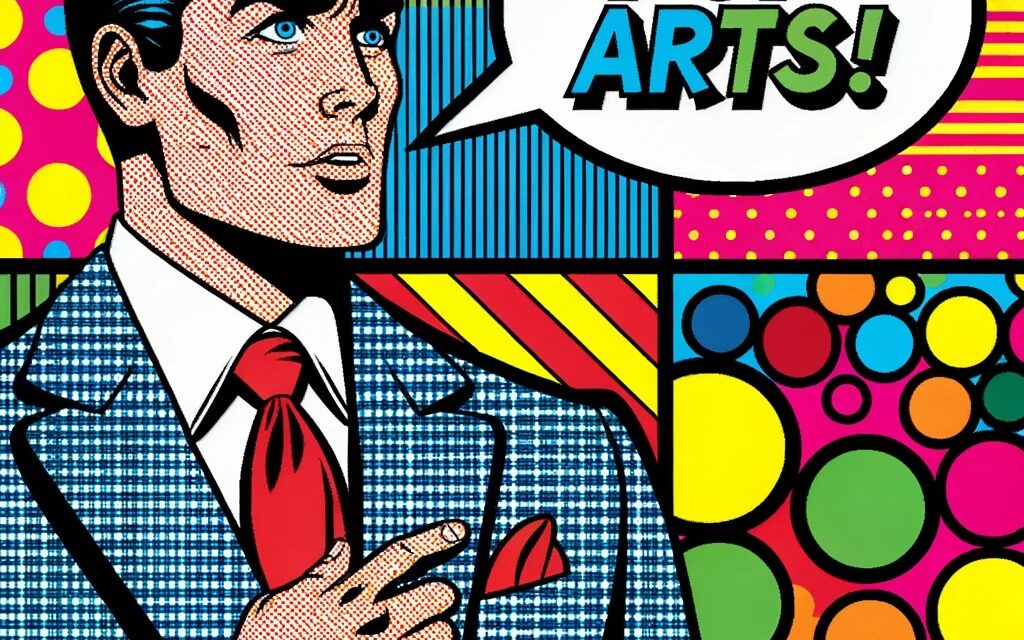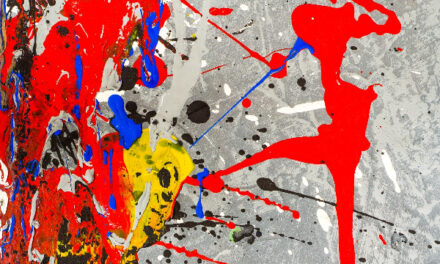Listen to this blog
Diving into the world of Pop Art is like unlocking a vibrant and striking segment of our contemporary culture. Famed for its bold hues, commercial subject matter and ironic undertones, Pop Art brings a unique flavor to the artistic arena. Vanquishing the conventional borders between high art and popular culture, it integrally embraces elements from advertising, comic books – indeed anything mass-produced becomes its raw material.
Born in Britain during the 1950s but flourishing in America by the 1960s, this avant-garde movement was a brilliant mirror to consumerist society; a satirical analysis wrapped within visually arresting, easily comprehensible forms. Influential figures such as Andy Warhol transformed soup cans into sculptures and Marilyn Monroe into iconic prints – an amalgamation of celebrity narratives with everyday items that forged a connection with viewers on an inherent level. With echoes still reverberating in today’s art scape, each delve into Pop Art promises an exciting chronicle of colour-powered rebellion against tradition!
Understanding the Basics of Pop Art
Delving into the vibrant universe of Pop Art is like opening a fantastic Pandora’s box, fizzing with dynamic images, lively colours and sharp commentary. It’s a culturally pivotal art movement that shook up conventions by challenging traditional high arts through its integration of popular culture and mundane elements. In essence, it encases a kaleidoscope of irony, fun and satire to question the representation of celebrities, commercial products or comic-book styles.
Perhaps one could see Pop Art as an audacious rebuttal to abstractionists – licking lollipop while giving knowing winks at orthodox elitism. Characterized by bright colours and simple forms without personal symbolism or emotional content– these aren’t just aesthetics; they present a mirror on society’s consumerist values and mass production tropes. Navigating around ‘Popland’, you find yourself reevaluating your relationship with things seen but unnoticed: A soup can? A comic strip? Pop artists challenge us to see them anew and perhaps read between the lines for their social satire content. This resonates particularly strongly in today’s Instagram-obsessed millennials’ culture, making it truly timeless paradigm-busting art!
History and Origins of Pop Art
Relembracing the past, pop art emerged as a radical revolt against traditional artistic values, lending colourful insights to our post-war consumer society. This new genre of fine art magnificently exploded from the UK and US in the mid to late 1950s. Pop art was primarily an affirmation of western capitalist culture, altering perceptions around commonplace objects and people. Artists like Andy Warhol, Roy Lichtenstein and Richard Hamilton celebrated these everyday commodities as they satirized the mass-media driven world.
What might startle enthusiasts is that Pop Art drew from a surprising source – Dadaism; an early 20th-century movement born out of negative response towards war horrors. Both movements encapsulated irony and mockery but differed in their approach towards capitalism – while Dadaists derided it, pop artists embraced it in all its chromatic jazziness. These intriguing origins remind us that pop art is much more than vintage soup cans or comic strips; it’s a vibrant commentary taking a deep dive into cultural transformation.
So whether you’re soaking up Lichtenstein’s comic-strip canvasses or admiring Warhol’s Campbell Soup Cans for the first time, remember each piece encapsulates messages born from profound historical moments that defined this extraordinary field of visual arts!
Notable Figures in Pop Art Movement
Arguably, when discussing the Pop Art movement, the mind immediately drifts to iconic figures such as Andy Warhol or Roy Lichtenstein. These artists put a spotlight on everyday objects and scenes through their distinctive styles – Warhol’s vibrant screen-printed images and Lichtenstein’s comic-strip-inspired works transformed ordinary into extraordinary thus questioning the standards of fine art. Yet, these two were not alone in propelling this avant-garde wave that flouted traditional art norms.
King of pop sculptures and master of unexpected materials, Claes Oldenburg stands out by bringing daily objects like burgers, typewriters or toilet paper rolls to ridiculously oversized dimensions. Meanwhile from across Atlantic shore, David Hockney brought his own vision of Pop Art with his bold colour palettes and minimalist yet evocative scenarios oozing nostalgia for California lifestyle. Lastly we have Eduardo Paolozzi – although lesser-known compared to his peers but widely credited as a pioneer who initiated the whole movement with collages of mass culture back in 1950s London; his approach was colder, more mechanical echoing industrial pace mirrored in society. This quartet alongside many others challenged artistic boundaries irreversibly changing our perception on what can be deemed as art.
Key Characteristics and Elements of Pop Art
Pop art, known for its bold, flashiness, and ironically substantive critique of post-World War II consumer culture, was radically unlike any art form that preceded it. It highlighted the irony of mass consumerism by freely mixing high and low culture in an electric melting pot. Famous pop artists like Andy Warhol and Roy Lichtenstein daringly repurposed popular imagery such as magazine ads, comic strips, or soup cans to emphasize the mundane yet pervasive nature of our materialistic society.
One notable element in Pop Art is its emphasis on banality and kitsch – glorifying everyday objects typically dismissed by “high-brow” art critics as trivial or tacky. This democracy in subject matter suggests that everything around us holds a cultural value worth exploring irrespective of traditional aesthetic hierarchies. Additionally, the vibrant colours and slick techniques used were often reminiscent of commercial printing methods (think Warhol’s Campbell’s Soup Can), reflecting Pop Art’s embrace of countercultural sensibilities while simultaneously critiquing excessive consumerist tendencies prevalent during its time.
Impact and Influence on Modern Art
The transformative power of Pop Art has reverberated through the edifice of art history, shaping a vision for contemporary creativity. It emerged in the mid-50s, challenging elitist culture by drawing inspiration from banal and kitschy elements, thus taking art out of exclusive museums to everyday life. This oscillation between ‘low’ and ‘high’ art expanded the horizon for modern artists who embraced this new vibrancy with hungry zeal.
Pop Art’s prolific influence pit stops not just at how we create but also deconstruct arts today. Its use of found objects, advertising imagery, and commonplace themes has led to revolutionary approaches like appropriation in modern design principles and conceptual art practices – signaling a clear continuum into 21st-century artistic evolution. The soul grabbing Warhol’s Campbell Soup Can or Lichtenstein’s comic strip paintings contextualize how seemingly ordinary can penetrate deep layers of societal consciousness – a trail blazed first by Pop Artists . Their immersive narrative style coupled with the unabashed celebration of consumerism daringly confronts viewers with society’s contradictions indicating that Pop Art endures not merely as an aesthetic revolution but paves way towards becoming an ideological manifesto around which Modern Art rallies.
Analysing Famous Pop Art Works
Peeking behind the pop art curtain, we can discuss unequivocal gems such as Andy Warhol’s Marilyn Diptych and Roy Lichtenstein’s Whaam! These works encapsulate the confluence of celebrity culture, advertising mechanics and comic strip style narratives which have become iconic hallmarks of this movement. Warhol’s silk-screened repetition in Marilyn Diptych showcases her everlasting fame through mass-production while Lichtenstein’s use of Ben-Day dots in Whaam! illustrates how public consciousness is deeply imprinted by comic aesthetics.
There’s a delicious irony that seeps from the vibrant colours and familiar imagery utilized in pop art. These luminaries hold a mirror to society, reflecting our fascination with consumerism and mundane objects. The Campbell Soup Cans by Warhol elevated an everyday item into an artistic sphere, challenging traditional notions about what constituted fine art. Meanwhile, Richard Hamilton’s Just What Is It That Makes Today’s Homes So Different? provides a satirical commentary on post-war prosperity rife with symbolism echoing domestic comfort interlaced with modern anxieties. As we dissect these famed artworks, we understand how these artists cleverly questioned societal norms using colourful irreverence that continues to bewitch us today.
Conclusion: The Continued Relevance of Pop Art
In conclusion, the enduring relevance of Pop Art is reflected in its unerring ability to challenge perceptions and engage with popular culture. Its piquant commentary on mass culture and consumerism resonates now, more than ever, in the era of social media engagement and influencer dominance. Love it or loath it; pop art remains a potent tool for unpacking societal norms.
Pop Art extends beyond Warhol’s Soup Cans or Lichtenstein’s Comic Strips; it reaches into society’s daily interactions offering an often irreverent dialogue on materialistic obsessions. This time-tested genre reinvents itself continuously, bending archetypes to suit today’s world, thereby marking its continued relevance. Lastly, who among us would turn down an opportunity to witness modern life mirrored boldly – stimulating immense thought while also encouraging laughter at the absurdity? Indeed, few other artistic movements resonate so deeply with our zeitgeist.




